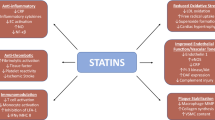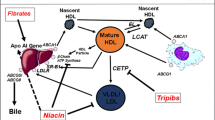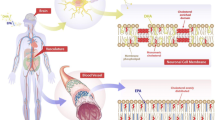Abstract
Convincing evidence from basic research and animal studies shows that 3-hydroxy-3-methylglutaryl coenzyme A (HMG CoA) reductase inhibitors (ie, statins) exert cardiovascular protective effects beyond cholesterol lowering. Because of the central role of low-density lipoprotein (LDL) cholesterol in mediating vascular pathology and the efficacy of statins for lowering LDL cholesterol, the clinical importance of these additional nonlipid effects remains to be determined. Nevertheless, there is growing evidence from recent clinical trials that suggests that some of the beneficial effects of statins may be unrelated to changes in LDL cholesterol. Indeed, in animal studies many of the cholesterol-independent or pleiotropic effects of statins are due predominantly to inhibition of isoprenoid, but not cholesterol, synthesis. Thus, with the recent findings of the Heart Protection Study and Anglo-Scandinavian Cardiac Outcomes Trial—Lipid Lowering Arm, the potential cholesterol-independent effects of statins have shifted the treatment strategy from numerical lipid parameters to the global assessment of cardiovascular risks.
Similar content being viewed by others
References
Laufs U, Liao JK: Direct vascular effects of HMG-CoA reductase inhibitors. Trends Cardiovasc Med 2001, 10:143–148.
Werner N, Nickenig G, Laufs U: Pleiotropic effects of HMG-CoA reductase inhibitors. Basic Res Cardiol 2002, 97:105–116.
Bonetti PO, Lerman LO, Napoli C, Lerman A: Statin effects beyond lipid lowering—are they clinically relevant? Eur Heart J 2003, 24:225–248.
Libby P, Aikawa M: Mechanisms of plaque stabilization with statins. Am J Cardiol 2003, 20:4B-8B.
Maron DJ, Fazio S, Linton MF: Current perspectives on statins. Circulation 2000, 101:207–213.
Wassmann S, Laufs U, Baumer AT, et al.: Inhibition of geranylgeranylation reduces angiotensin II-mediated free radical production in vascular smooth muscle cells: involvement of angiotensin AT1 receptor expression and Rac1 GTPase. Mol Pharmacol 2001, 59:646–654.
Wassmann S, Laufs U, Muller K, et al.: Cellular antioxidant effects of atorvastatin in vitro and in vivo. Arterioscler Thromb Vasc Biol 2002, 22:300–305.
Takemoto M, Node K, Nakagami H, et al.: Statins as antioxidant therapy for preventing cardiac myocyte hypertrophy. J Clin Invest 2001, 108:1429–1437.
Laufs U, Kilter H, Konkol C, et al.: Impact of HMG CoA reductase inhibition on small GTPases in the heart. Cardiovasc Res 2002, 53:911–920.
Goldstein JL, Brown MS: Regulation of the mevalonate pathway. Nature 1990, 343:425–430.
Laufs U, Liao JK: Targeting Rho in cardiovascular disease. Circ Res 2000, 87:526–528.
Laufs U, Liao JK: Post-transcriptional regulation of endothelial nitric oxide synthase mRNA stability by Rho GTPase. J Biol Chem 1998, 273:24266–24271.
Tamai O, Matsuoka H, Itabe H, et al.: Single LDL apheresis improves endothelium-dependent vasodilatation in hypercholesterolemic humans. Circulation 1997, 95:76–82.
Pasternak RC, Smith SC Jr, Bairey-Merz CN, et al.: ACC/AHA/NHLBI clinical advisory on the use and safety of statins. Circulation 2002, 106:1024–1028.
Smith SC Jr, Blair SN, Bonow RO, et al.: AHA/ACC guidelines for preventing heart attack and death in patients with atherosclerotic cardiovascular disease: 2001 update. A statement for healthcare professionals from the American Heart Association and the American College of Cardiology. J Am Coll Cardiol 2001, 38:1581–1583.
Shepherd J, Cobbe SM, Ford I, et al.: Prevention of coronary heart disease with pravastatin in men with hypercholesterolemia. West of Scotland Coronary Prevention Study Group. N Engl J Med 1995, 333:1301–1307.
Sacks FM, Pfeffer MA, Moye LA, et al.: The effect of pravastatin on coronary events after myocardial infarction in patients with average cholesterol levels. Cholesterol and Recurrent Events Trial investigators. N Engl J Med 1996, 335:1001–1009.
Scandinavian Simvastatin Study Group: Randomised trial of cholesterol lowering in 4444 patients with coronary heart disease: the Scandinavian Simvastatin Survival Study (4S). Lancet 1994, 344:1383–1389.
Knatterud GL, Rosenberg Y, Campeau L, et al.: Long-term effects on clinical outcomes of aggressive lowering of low-density lipoprotein cholesterol levels and low-dose anticoagulation in the post coronary artery bypass graft trial. Post CABG Investigators. Circulation 2000, 102:157–165.
Heart Protection Study Group: MRC/BHF Heart Protection Study of cholesterol lowering with simvastatin in 20,536 high-risk individuals: a randomised placebo-controlled trial. Lancet 2002, 360:7–22.
Sever PS, Dahlof B, Poulter NR, et al.: Prevention of coronary and stroke events with atorvastatin in hypertensive patients who have average or lower-than-average cholesterol concentrations, in the Anglo-Scandinavian Cardiac Outcomes Trial-Lipid Lowering Arm (ASCOT-LLA): a multicentre randomised controlled trial. Lancet 2003, 361:1149–1158.
Packard CJ: Influence of pravastatin and plasma lipids on clinical events in the West of Scotland Coronary Prevention Study (WOSCOPS). Circulation 1998, 97:1440–1445.
Pekkanen J, Linn S, Heiss G, et al.: Ten-year mortality from cardiovascular disease in relation to cholesterol level among men with and without preexisting cardiovascular disease [see comments]. N Engl J Med 1990, 322:1700–1707.
Buchwald H, Varco RL, Boen JR, et al.: Effective lipid modification by partial ileal bypass reduced long-term coronary heart disease mortality and morbidity: five-year posttrial follow-up report from the POSCH. Program on the Surgical Control of the Hyperlipidemias. Arch Intern Med 1998, 158:1253–1261.
Schwartz GG, Olsson AG, Ezekowitz MD, et al.: Effects of atorvastatin on early recurrent ischemic events in acute coronary syndromes: the MIRACL study: a randomized controlled trial. JAMA 2001, 285:1711–1718.
John S, Delles C, Jacobi J, et al.: Rapid improvement of nitric oxide bioavailability after lipid-lowering therapy with cerivastatin within two weeks. J Am Coll Cardiol 2001, 37:1351–1358.
Tsunekawa T, Hayashi T, Kano H, et al.: Cerivastatin, a hydroxymethylglutaryl coenzyme a reductase inhibitor, improves endothelial function in elderly diabetic patients within 3 days. Circulation 2001, 104:376–379.
Laufs U, Wassmann S, Hilgers S, et al.: Rapid effects on vascular function after initiation and withdrawal of atorvastatin in healthy, normocholesterolemic men. Am J Cardiol 2001, 88:1306–1307.
Kaesemeyer WH, Caldwell RB, Huang J, Caldwell RW: Pravastatin sodium activates endothelial nitric oxide synthase independent of its cholesterol-lowering actions. J Am Coll Cardiol 1999, 33:234–241.
O’Driscoll G, Green D, Taylor RR: Simvastatin, an HMG-coenzyme A reductase inhibitor, improves endothelial function within 1 month. Circulation 1997, 95:1126–1131.
Masumoto A, Hirooka Y, Hironaga K, et al.: Effect of pravastatin on endothelial function in patients with coronary artery disease (cholesterol-independent effect of pravastatin). Am J Cardiol 2001, 88:1291–1294.
Heeschen C, Hamm CW, Laufs U, et al.: Withdrawal of statins increases event rates in patients with acute coronary syndromes. Circulation 2002, 105:1446–1452.
Thomas M, Mann J: Increased thrombotic vascular events after change of statin. Lancet 1998, 352:1830–1831.
Aikawa M, Rabkin E, Sugiyama S, et al.: An HMG-CoA reductase inhibitor, cerivastatin, suppresses growth of macrophages expressing matrix metalloproteinases and tissue factor in vivo and in vitro. Circulation 2001, 103:276–283.
Sukhova GK, Williams JK, Libby P: Statins reduce inflammation in atheroma of nonhuman primates independent of effects on serum cholesterol. Arterioscler Thromb Vasc Biol 2002, 22:1452–1458.
Ridker PM, Hennekens CH, Buring JE, Rifai N: C-reactive protein and other markers of inflammation in the prediction of cardiovascular disease in women. N Engl J Med 2000, 342:836–843.
Ridker PM, Rifai N, Clearfield M, et al.: Measurement of C-reactive protein for the targeting of statin therapy in the primary prevention of acute coronary events. N Engl J Med 2001, 344:1959–1965.
Ridker PM, Rifai N, Lowenthal SP: Rapid reduction in C-reactive protein with cerivastatin among 785 patients with primary hypercholesterolemia. Circulation 2001, 103:1191–1193.
Ridker PM, Rifai N, Pfeffer MA, et al.: Long-term effects of pravastatin on plasma concentration of C-reactive protein. The Cholesterol and Recurrent Events (CARE) Investigators. Circulation 1999, 100:230–235.
Southworth MR, Mauro VF: The use of HMG-CoA reductase inhibitors to prevent accelerated graft atherosclerosis in heart transplant patients. Ann Pharmacother 1997, 31:489–491.
Goldberg R, Roth D: Evaluation of fluvastatin in the treatment of hypercholesterolemia in renal transplant recipients taking cyclosporine. Transplantation 1996, 62:1559–1564.
Kobashigawa JA, Katznelson S, Laks H, et al.: Effect of pravastatin on outcomes after cardiac transplantation. N Engl J Med 1995, 333:621–627.
Rosenson RS, Tangney CC, Casey LC: Inhibition of proinflammatory cytokine production by pravastatin. Lancet 1999, 353:983–984.
Vaughan CJ: Prevention of stroke and dementia with statins: Effects beyond lipid lowering. Am J Cardiol 2003, 91:23B-29B.
Byington RP, Davis BR, Plehn JF, et al.: Reduction of stroke events with pravastatin: the Prospective Pravastatin Pooling (PPP) project. Circulation 2001, 103:387–392.
Klungel OH, Heckbert SR, de Boer A, et al.: Lipid-lowering drug use and cardiovascular events after myocardial infarction. Ann Pharmacother 2002, 36:751–757.
Endres M, Laufs U, Huang Z, et al.: Stroke protection by 3-hydroxy-3-methylglutaryl (HMG)-CoA reductase inhibitors mediated by endothelial nitric oxide synthase. Proc Natl Acad Sci U S A 1998, 95:8880–8885.
Laufs U, Liao JK: Rapid effects of statins: from prophylaxis to therapy for ischemic stroke. Arterioscler Thromb Vasc Biol 2003, 23:156–157.
Williams JK, Sukhova GK, Herrington DM, Libby P: Pravastatin has cholesterol-lowering independent effects on the artery wall of atherosclerotic monkeys. J Am Coll Cardiol 1998, 31:684–691.
Reihner E, Rudling M, Stahlberg D, et al.: Influence of pravastatin, a specific inhibitor of HMG-CoA reductase, on hepatic metabolism of cholesterol. N Engl J Med 1990, 323:224–228.
Blum CB: Comparison of properties of four inhibitors of 3-hydroxy-3- methylglutaryl-coenzyme A reductase. Am J Cardiol 1994, 73:3D-11D.
McTaggart F, Buckett L, Davidson R, et al.: Warwick M. Preclinical and clinical pharmacology of Rosuvastatin, a new 3-hydroxy-3-methylglutaryl coenzyme A reductase inhibitor. Am J Cardiol 2001, 87:28B-32B.
Dobrucki LW, Kalinowski L, Dobrucki IT, Malinski T: Statin-stimulated nitric oxide release from endothelium. Med Sci Monit 2001, 7:622–627.
Laufs U, Gertz K, Dirnagl U, et al.: Rosuvastatin, a new HMG-CoA reductase inhibitor, upregulates endothelial nitric oxide synthase and protects from ischemic stroke in mice. Brain Res 2002, 942:23–30.
Corsini A, Bellosta S, Baetta R, et al.: New insights into the pharmacodynamic and pharmacokinetic properties of statins. Pharmacol Ther 1999, 84:413–428.
Trauner M, Boyer JL: Bile salt transporters: molecular characterization, function, and regulation. Physiol Rev 2003, 83:633–671.
Thompson PD, Clarkson P, Karas RH: Statin-associated myopathy. JAMA 2003, 289:1681–1690.
Assmann G, Cullen P, Schulte H: Simple scoring scheme for calculating the risk of acute coronary events based on the 10-year follow-up of the prospective cardiovascular Munster (PROCAM) study. Circulation 2002, 105:310–315.
Takemoto M, Liao JK: Pleiotropic effects of 3-hydroxy-3-methylglutaryl coenzyme a reductase inhibitors. Arterioscler Thromb Vasc Biol 2001, 21:1712–1719.
Author information
Authors and Affiliations
Rights and permissions
About this article
Cite this article
Laufs, U., Liao, J.K. Isoprenoid metabolism and the pleiotropic effects of statins. Curr Atheroscler Rep 5, 372–378 (2003). https://doi.org/10.1007/s11883-003-0008-z
Issue Date:
DOI: https://doi.org/10.1007/s11883-003-0008-z




